Soccer drills
Set up your team in 2 lines (4-5 per line max) - only 1 ball needed.
IMPLEMENTATION:
- Players take the ball and then play it to the first person in the line opposite to them. Immediately after the pass they draw a sprint and close the back of the line they just played in. This is repeated over and over again.
QUALITY:
- Players are all on their toes ready for the pass.
- Passes are clear and accurate.
- Players must shout if they want the ball to play, and also shout the name to whom they are passing again.
- With the first ball contact they bring the ball under control, the second ball contact is the pass to the other player.
PROGRESS:
- Apply only one pass.
- Let one line pick up the ball and throw it back to the other line. They will then play the ball back with a volleypass and then simply join the other line.
- Let players take the ball with their thigh and bring it under control after which they pass the ball back over the ground.
- Place a pawn 5 meters on either side of the central point between the 2 lines. After the pass, the players have to walk around the pawn after which they connect in the row.
- Split your team into four teams of four
- 1 ball per team
IMPLEMENTATION:
- Players play the ball around within their team of four in the area that was put out
QUALITY:
- Players are constantly moving, with many tempo changes to find space.
- Each team must try to maintain a diamond shape
- Players must all communicate with teammates, the ball must be asked for and the player's name must be called by the person who is playing the ball.
- Passes should arrive well, in space or in the feet.
- Players should not touch each other, nor should the balls touch each other.
- This exercise requires great vigilance on the part of the players.
PROGRESS:
- Add a passive defender who can defend any ball.
- Add a defender who can conquer the ball.
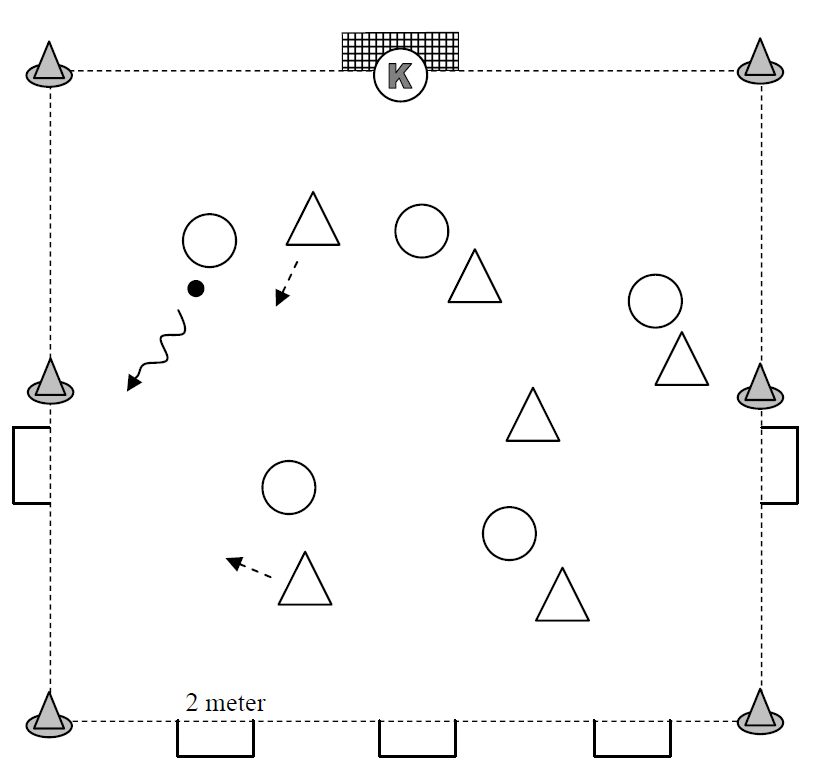
Organization:
There will be 6 against 5 + goalkeeper.
If the party that has to score on the big goal has lost the ball, they have to defend 5 goals.
After 15 minutes of changing halves.
Remarks:
If the attackers of the triangle game lose the ball, it can very quickly result in a counter-goal.
Especially the players who don't play in the league games can't like this kind of game.
Points of attention:
Cover the man in time.
Do not go in recklessly.
Cover on the good side.
Posture during the duels, through the knees.

Organization:
There is 3:3 played. Without goalkeepers.
On the goal of 7 meters may only be scored from the 16 meters area.
The other party can score on the 2 goals, from any position.
If the ball goes out at the sides, it is restarted with a kick.
After a goal or if the ball passes the backline, the game is restarted on the back line of the offensive team (triangles).
There will also be 2 new defenders and 3 new attackers in the field.
Points of attention:
Fierce defending before they are in the 16 meter area.
Make the field small when defending.
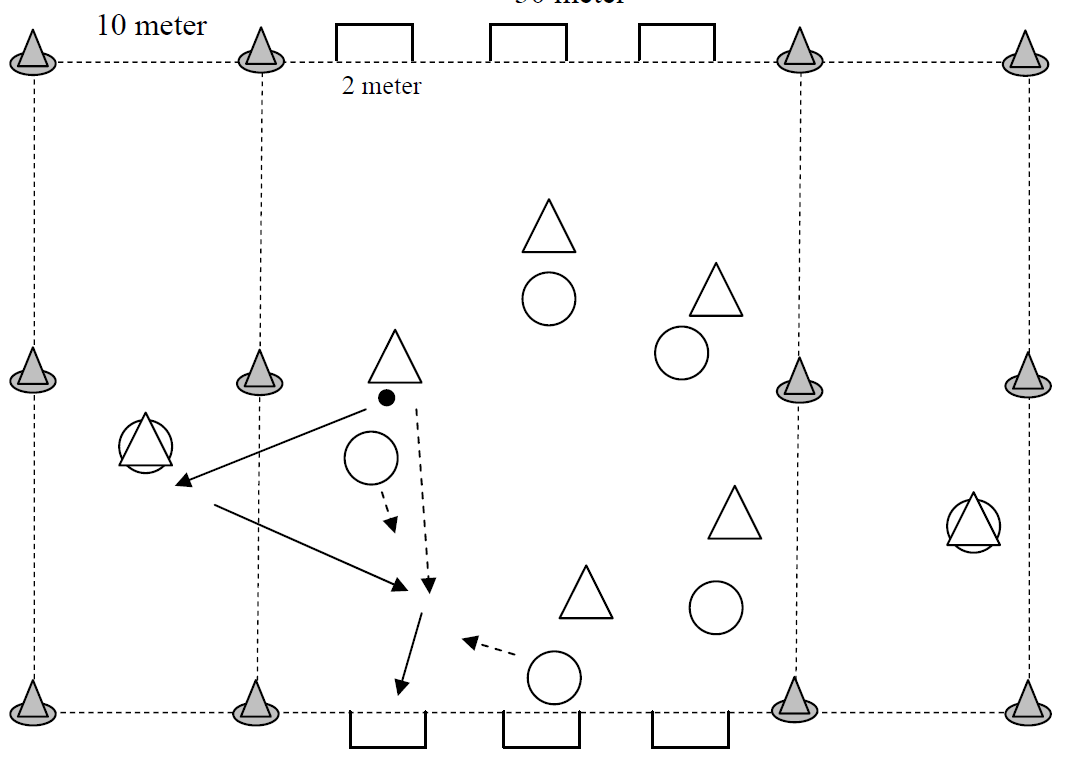
Organization:
There will be 5:5 or 4:4 with extra players on the sides, the wingers. These 2 players are with the ball owning team.
The wing players may dribble with the ball first.
After a few minutes they have to play immediately.
The players on the sides are not allowed to score.
After 10 minutes or a little less the offside players change.
Remarks:
Players sometimes find it better to keep their own man, than to prevent a goal by stepping in or covering an opponent standing closer to the goal. Let them do it wrong a few times first. Use these situations later to give them directions.
Points of attention:
Do they know how their fellow players stand when they have to defend?
Don't let anyone release his marked man.
Stand between the opponent and the goals.
Have them positioned so that they can see the opponent and the ball.
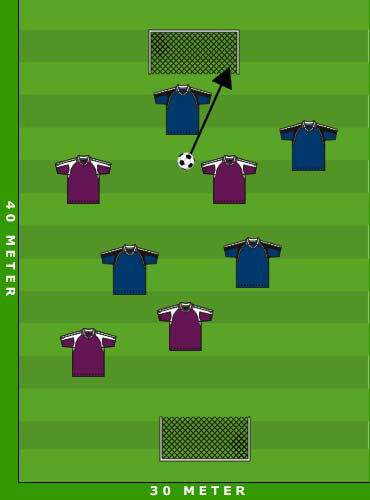
Field setup:
2 big goals
Gameplay:
This can be in 4 against 4 or 3 against 3 setup. Both teams play with a small ball and have to overpass given the size of the field. Because of the small field and the small ball, they are forced to take the ball well and pass cleanly.
Game rules/tips:
- Scoring can be done in 2 ways: if the ball is kicked over the line, 1 point is deducted from the score and if the ball is scored in the goal, 1 point is added to the score.
- If the ball is scored or kicked over the line, the ball must be given to the other team.
- It is not allowed to score from one's own half.
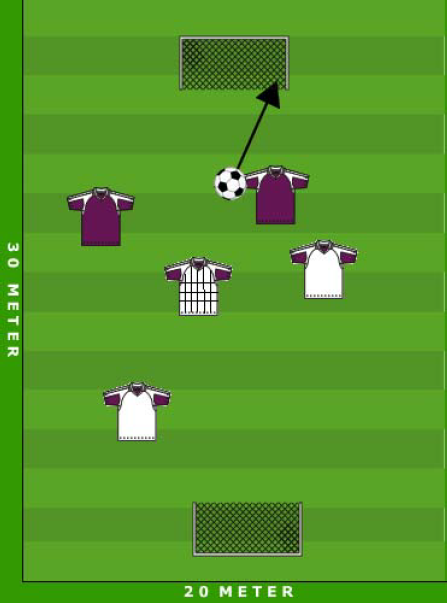
Field setup:
2 big goals
Gameplay:
2 players purple play against 3 players white. White plays with a chameleon. This means that when an attack is set up by the purple team, the chameleon plays with to the purple team. When an attack is set up by the white team, the chameleon belongs to the white team.
Rules/tips:
- If a goal is scored, the ball must be given to the other team.
- You may not score from your own half.
- If the ball has crossed the line, it must be thrown in.
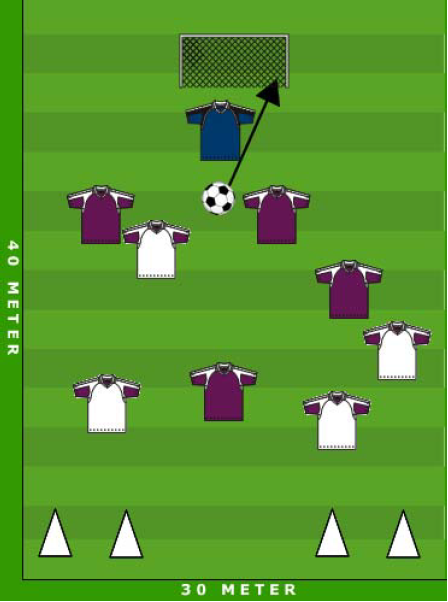
Field setup:
1 large goal and 2 small pylon goals along each line and 1 ball.
Course of play:
4 players purple play a game against 4 players white.
Laws/tips:
- If a goal is scored, the ball must be given to the other team.
- You may not score from your own half.
- If the ball is over the line it must be thrown in.
- The attackers must score on the big goal and the defenders on the 2 small pylon goals.
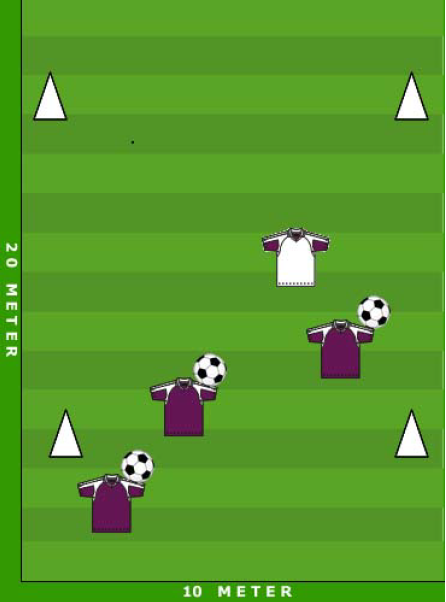
Field setup:
Put out a field with 4 pawns at 20 by 10 meters.
Course of play:
Players must come from one side of the field with a ball on the other side. In the middle is the ball collector. This player should try to take the ball from the running players.
Rules of the game:
- Watch carefully where and when you can run over with the ball.
- The collector must try to chase the players to the side.
- If the collector touches the ball from another player, the player who has touched the ball must be in the middle.
- If the ball goes over the sideline of a player then the player is also off and becomes the collector.
- You may not walk back over the imaginary backline.
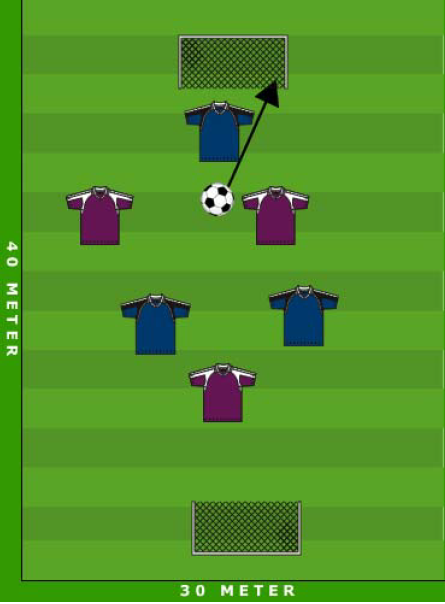
Field setup:
2 goals along each line and 1 ball.
Course of play:
3 players in blue play a game against 3 players in purple.
Game rules/tips:
- If a goals is scored, the ball must be given to the other team.
- You may not score from your own half.
- If the ball is over the line it must be thrown in.
- It is important to make triangles on the field to be able to pass the ball well to each other without the opponent being able to get in between.
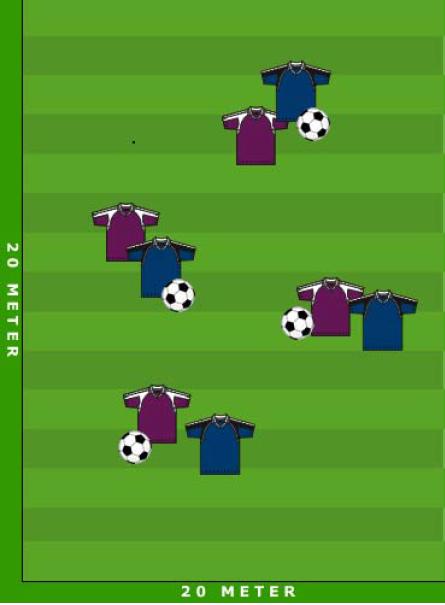
Field setup:
Put out a field with 4 pylons at 20 by 20 meters.
Course of play:
Every 2 players get one ball. The purple player must try to shield the ball in front of the blue player. The blue player must try to get the ball without making a foul.
Rules of the game:
- If a player takes the ball, then this player may shield the ball and the other player must take the ball back.
- On the whistle signal of the trainer you have to switch players.
- You may not switch to another player that you have already played against once.
- When shielding the ball, use your body well.
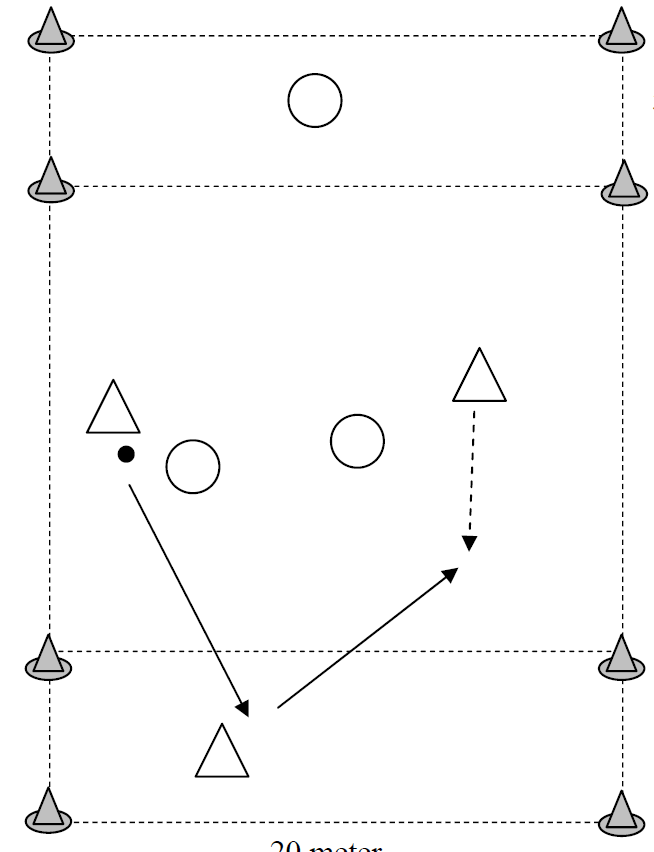
Organization:
2:2 will be played on 2 fields. The players in the so called striker squares at the top and bottom serve as goals.
They can score by playing their fellow player in the striker area, he must get the ball under control in this area. After a goal, the other party may start.
After this, the game is played with a first-time ball. The striker gets the ball and has to play it directly back to a fellow player. Only now a point is scored.
The strikers are not allowed to come out of their box, and the other players are not allowed in the striker's box.
After 8 minutes of substitution
Points of attention:
First check if the other player has played the ball correctly, then ask for the ball through a running action.
If you pass cleanly, then the striker can also play back well.








